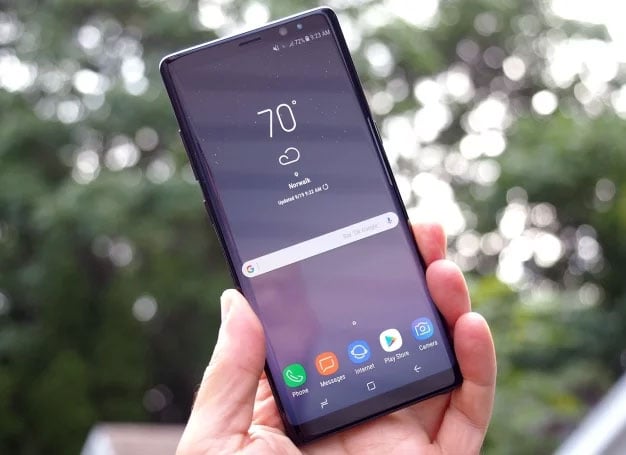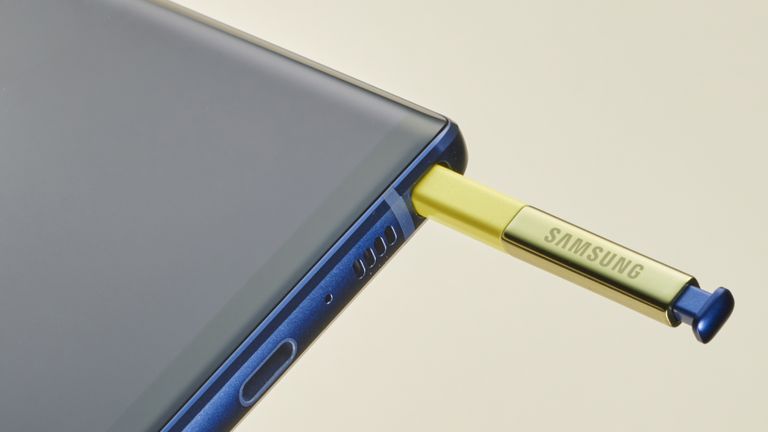
Also Read: Samsung Announces Pre-Order Latest Galaxy Note 9 Smartphone: 4000mAh Battery And New S-Pen
The Galaxy Note 9 has a feature designed to keep this flagship cool while delivering consistent speed: Samsung put a water-carbon cooling system in the device to keep it from breaking a sweat while you're in the middle of an extended Fortnite session.
The advanced carbon-water cooling system, combined with a heat sink that's three times larger than the one inside the Note 8, helps with heat dissipation. Samsung says those improvements can prevent overheating by 21 percent, but the company is emphasizing performance over temperatures.

We decided to put the Note 9's cooling to the test, and the results are mixed.
Sustained performance: Better than Galaxy S9, but not OnePlus 6
The Galaxy Note 9 does deliver better sustained speeds than the Galaxy S9+ when performing demanding tasks. We used the Antutu benchmark, which measures CPU, GPU memory and other aspects of performance and ran it seven consecutive times on both phones.
The Galaxy Note 9 delivered a higher max score of 271,018, and it never dropped below 222,000. On the same set of tests, the Galaxy S9+ dropped below 222,000 three times, once falling to 195,728. That’s a drop of 22 percent from the S9+’s max score. The Note 9’s biggest drop was 15 percent.

However, it’s not all good news for Samsung’s water cooling. The OnePlus 6 on the same test started at 286,889 on Antutu and fell to only 272,531 on the seventh run. That’s a drop of only 5 percent. It's worth noting that the OnePlus 6 we used has 8GB of RAM, or 2GB more than the Galaxy Note 9.
On the other hand, the Note 9 did a better job of keeping its cool throughout this test than the OnePlus 6. The latter phone reached 100 degrees on the last run, while the Note 9 registered 93 degrees. In fact, the Note 9 stayed fairly cool throughout the test as the OnePlus 6 heated up.
The Galaxy S9+ also stayed fairly cool, though, starting at 97 degrees and settling at 94 degrees.

Indoor tests: Note 9 is not the coolest
For the first test in our indoor lab, we ran CPU Loader, a CPU stress test; and 3DMark Slingshot Extreme Unlimited, a graphics performance test, simultaneously for 15 minutes, to put extra strain on each phone's processor. At the end of the tests, both Notes registered 100 degrees Fahrenheit (as measured by our heat gun) on both the front and back of the devices; there was no noticeable temperature difference even in feel. We consider anything above 95 degrees uncomfortably warm.
Next, we put the Note 9, Note 8 and iPhone X through two 15-minute AnTuTu benchmarks, recording the temperature every 5 minutes to gather an average. Here, the Note 8 actually proved the coolest, registering an average of 99.6 degrees. The Note 9 came in second, at 100.6 degrees, and the iPhone X ran the hottest, at 100.9 degrees. We measured the front and back of the devices, which were comparable in temperature.

When we measured the final temperature of each phone, the running order changed again. This time, the Note 9 was actually the hottest, hitting 106 degrees; the Note 8 topped out at 103 degrees, and the iPhone X hit 102 degrees.
Finally, we ran a few quick races of Asphalt 9: Legends with both Galaxy Note devices. Again, both handsets got equally hot — about 90 degrees — though the Note 9 felt ever so slightly cooler in the palm than the Note 8.
The torture test: Outside on a hot summer day
It was sunny and 88 degrees in New York when we visited Bryant Park to conduct the outdoor portion of our overheating test. We set the Galaxy Note 9, Note 8 and iPhone X down on a metal table that had been baking underneath the sun, then ran 3D Mark's Slingshot OpenGL ES 3.1 repeatedly until it produced a heat warning on each phone, recording the surface temperatures of the devices along the way.

The iPhone X was the first to show beads of sweat, slowing to an average of 3 frames per second after enduring about 6 minutes of 3DMark's test. In comparison, the Note 9 hovered at 14 fps, and the Note 8 delivered 11 fps. The iPhone eventually became unresponsive at 14 minutes and 30 seconds, serving up a temperature warning that prevented us from using the device at all until it sufficiently cooled down. It measured 125 degrees on our heat gun at that point.
Both Notes exhibited more endurance than the iPhone X, but the Note 9's water carbon cooling system didn't seem to make any noticeable difference.
Both Notes exhibited more endurance, but interestingly, the Note 9's cooling system didn't seem to make any noticeable difference. Both the Note 9 and the Note 8 called it quits at 130 degrees, and both lasted exactly 17:30 before overheating notifications popped up. Frankly, the consistency was pretty surprising, given that the Note 9 uses a water cooling system with carbon fiber (the Note 8 also uses water cooling, but without carbon fiber). That's supposed to make a difference, but in our tests, it didn't.
It's important to note that, unlike the iPhone, Android's heat management doesn't render the phone useless until it cools down. Rather, Android discreetly closes certain apps that are generating the most energy while letting you use the rest of the device normally. But even when the two Note phones decided enough was enough, they were still reasonably responsive. Meanwhile, the iPhone's animations slowed to a crawl minutes before it told us it needed to cool down. It was almost unusable.

Bottom line
The Galaxy Note 9 does deliver bettter sustained performance than the Galaxy S9+, which doesn't benefit from the Note 9's more advanced carbon water cooling. However, the Galaxy S9 stayed just as cool. The OnePlus 6 ran hotter on our tests, but it actually managed to deliver better performance over successive benchmark runs than the Note 9.
So does the Note 9's water cooling work? Yes when it comes to delivering more consistent performance, but not necessarily in terms of keeping temps low.

إرسال تعليق